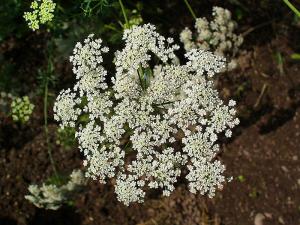Greater Ammi

Ammi majus, also known as Bishop's flower, Bishop’s weed, False bishop’s weed, Bullwort, Greater ammi, Lady’s lace, Queen Anne's lace, and Laceflower, is a commonly grown ornamental annual. Originally introduced from Asia, the plant has become widely established throughout the coastal regions of the southern United States. The plant has white lace-like flower clusters at the end of a 1 to 2 foot stem.
The plant is toxic and poses a risk to both companion and agricultural animals. The primary toxins are furanocoumarins (5 and 8-Methoxypsoralen (bergapten and xanthotoxin respectively)) and nitrates. All parts of the plant, but especially the seeds, are toxic and have been shown to cause photosensitization in companion animals, cattle, sheep, fowl, and humans as a result of ingestion or skin contact with the plant and subsequent exposure to sunlight.
Photosensitization is a clinical condition in which areas exposed to light and lacking significant protective hair, wool, or pigmentation become hyperreactive to sunlight due to the presence of photodynamic agents. When animals ingest the plant their body is unable to fully metabolize it. This allows photoreactive compounds to be deposited throughout the tissues of the body. When exposed to the UV radiation of sunlight, the now photoreactive tissue reacts by becoming energized. This reaction yields free radicals that literally “burn” the tissue. The affected tissue will become wrinkled, blistered, or split apart creating open wounds, and the surface may eventually slough away. It may take weeks to recover and obvious scarring may remain forever. Additionally the tissue damage may be so severe that it completely debilitates the animal or allows necrosis and secondary infections that kill the animal. Even more damaging than how it affects the skin is how it affects the eyes, in that animals may experience cloudy corneas, conjunctivokeratitis and permanent scaring of the eyes that leaves the animal blind.
There is no specific antidote for ingestion of Ammi majus, as such treatment is going to be palliative. In the event the animal is witnessed eating the plant or identifiable plant matter is found in the mouth remove any existing plant matter from the mouth and flush the mouth thoroughly with water. In dogs and cats vomiting may be induced by giving a teaspoon or less (size dependent) of 3% hydrogen peroxide orally; a cathartic to stimulate elimination may prove beneficial. Gastric lavage and the administration of activated medical charcoal may be very useful in ridding the body of the toxin. While the photosensitivity continues, the animal should be kept away from sunlight and fully shaded. For grazing animals, they should be housed in a cool dark place during the day and only allowed to graze during darkness. The severe stress of photosensitization and extensive skin necrosis can be highly debilitating and increase mortality. Corticosteroids, given parenterally in the early stages, may be helpful. Secondary skin infections and suppurations should be treated with basic wound management techniques, and fly strike prevented. The skin lesions heal remarkably well, even after extensive necrosis. The prognosis for animals that receive treatment is good, and most will recover in days to weeks; although visible scarring and/or damage to the eyes may remain for the life of the animal.




